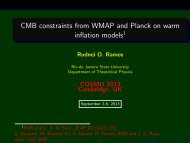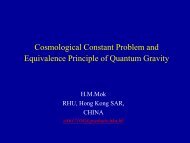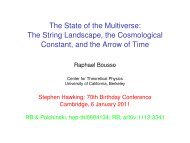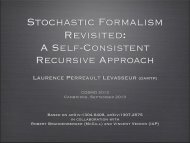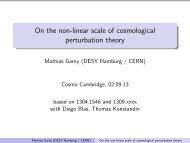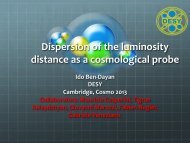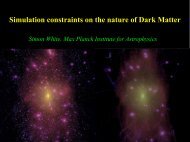Primordial trispectrum and orthogonal non-Gaussianities
Primordial trispectrum and orthogonal non-Gaussianities
Primordial trispectrum and orthogonal non-Gaussianities
Create successful ePaper yourself
Turn your PDF publications into a flip-book with our unique Google optimized e-Paper software.
<strong>Primordial</strong> <strong>trispectrum</strong> <strong>and</strong><strong>orthogonal</strong> <strong>non</strong>-<strong>Gaussianities</strong>Sébastien Renaux-PetelLagrange Institute - LPTHE, Paris.Cosmo 13, Cambridge,03.09.13
Motivations / message• Data analysis of the <strong>trispectrum</strong> has received much lessattention than the bispectrum: only• Until recently, no counterpart to <strong>orthogonal</strong> bispectrum• Generation of ‘<strong>orthogonal</strong>-type’ trispectra in asignificant fraction of parameter space in the simplesttheoretical context• Use as a diagnostic for the appearance of a large<strong>orthogonal</strong> bispectrum (pre-Planck)Renaux-Petel,1302.6978<strong>and</strong>1303.2618
EFT of single-clock inflation• Unitary gauge action:Cheungetal,0709.0293• Lowest order in derivatives, up to 4th order in fluctuations:• Stückelberg time diffeomorphism in thedecoupling regime (neglect the mixing with gravity)with approximate shift-symmetry: constant
EFT of single-clock inflation(leading-order terms in the low sound speed limit)For A <strong>and</strong> B of order one, all operators introduce thesame strong coupling scale technically naturalWell known bispectrum: one-parameter family ofshapes; equilateral, <strong>and</strong> <strong>orthogonal</strong> for 3.1 < A < 4.2
TrispectrumSet-up computationaly equivalent to k-inflationChen et al,0905.3494s=scalarexchangec=contactinteractions
‘Equilateral’ <strong>trispectrum</strong>All 4 shapes are similar, <strong>and</strong> peak near the regulartetrahedron (RT) limitSimple representative ansatz:Simple measure of the amplitude:Only constraint to date on a <strong>trispectrum</strong> fromquantum origin (<strong>non</strong>-local type) :AssumingFergusson,Regan,Shellard(10)
A diagnostic of a large <strong>orthogonal</strong>bispectrum (pre-Planck)WMAP9 (weakly) favoredvalues of c s of order 10 -2For such values, the<strong>trispectrum</strong>, scaling likeWMAP9is of order 10 8 <strong>and</strong> is greaterthan the observationalboundStrong constraints on models that can generate the large<strong>orthogonal</strong> bispectrum suggested by WMAP9 … unless theobservational bound is not applicable!
TrispectrumTwo-parameter family of shapes. For any A, T interpolatesbetween highly correlated <strong>and</strong> anti-correlated with Tc1 as Bgoes from large negative to positive values. A shapequalitatively different from Tc1 necessarily arises in theneighborhood of a particular value of B (function of A).Around which value? How narrow is this region?What does the shape look like? How does it vary with A?
Orthogonal <strong>trispectrum</strong>In 1302.6978, we concentrated on the region 3.1< A < 4.2where the <strong>orthogonal</strong> bispectrum arises, motivated by thehints of a large <strong>orthogonal</strong> bispectrum in WMAP9 analysis.Visual inspection of shapes invarious representative limits:Tc1 is representative only forA qualitatively different shapearises in the complementaryregion, centered around:The shapes of these various <strong>orthogonal</strong> trispectra dependvery weakly on A
Orthogonal <strong>trispectrum</strong>Plots of the dimensionless quantitiesSpecializedplanar limitFolded limitMore in 1302.6978
Family of <strong>orthogonal</strong> trispectraMore generally, the cancellation of tNL gives a goodestimate of when Tc1 is not representative of the totalshape.One-parameter family of ‘<strong>orthogonal</strong>-type’ trispectra:This is in full agreement with the visual inspection of shapes
Conclusion• Data analysis of the <strong>trispectrum</strong> has received much lessattention than the bispectrum. Until recently, nocounterpart to <strong>orthogonal</strong> bispectrum.• We have shown that the simple ‘equilateral’ ansatz usedto represent trispectra from derivative operators is notenough: qualitatively new ‘<strong>orthogonal</strong>-type’ trispectra aregenerated in a substantial fraction of parameter space inthe simplest theoretical context. Current constraints aremostly blind to them. Need for dedicated data analysis.• See 1303.2618 for a discussion of the <strong>trispectrum</strong> in thecase of DBI-Galileon inflation, which can generate abispectrum of <strong>orthogonal</strong> shape.



